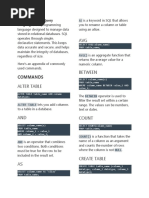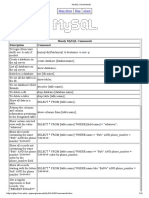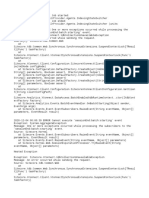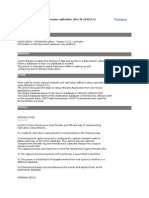0 ratings0% found this document useful (0 votes)
111 viewsSQL-Commands-revision - Sheet (Nisha - Jha)
SQL commands allow users to query and manipulate data. The main commands are SELECT, INSERT, UPDATE, DELETE, and ALTER. SELECT is used to retrieve data from one or more tables. INSERT adds new rows to a table. JOIN combines rows from two or more tables based on a related column between them.
Uploaded by
Santosh KumarCopyright
© © All Rights Reserved
Available Formats
Download as PDF, TXT or read online on Scribd
0 ratings0% found this document useful (0 votes)
111 viewsSQL-Commands-revision - Sheet (Nisha - Jha)
SQL commands allow users to query and manipulate data. The main commands are SELECT, INSERT, UPDATE, DELETE, and ALTER. SELECT is used to retrieve data from one or more tables. INSERT adds new rows to a table. JOIN combines rows from two or more tables based on a related column between them.
Uploaded by
Santosh KumarCopyright
© © All Rights Reserved
Available Formats
Download as PDF, TXT or read online on Scribd
You are on page 1/ 1
SQL COMMANDS
Commands and syntax for Commands and syntax for querying
Command Syntax Description Command Syntax Description
querying data from Single Table data from Multiple Table
It is an clause in SQL used SELECT column_name(s) SELECT c1, c2
SELECT column_name, COUNT(*) It is sued to combine rows
SELECT c1 FROM t FROM t1
Revision sheet
for aggregate functions in FROM table_1
GROUP BY FROM table_name from different tables even INNER JOIN t2 on condition
collaboration with the OUTER JOIN LEFT JOIN table_2
GROUP BY column_name; if the condition is NOT To select the data in Column c1 Select column c1 and c2 from table
SELECT statement ON table_1.column_name =
The commands in SQL are called Queries and they are of two types: TRUE from table t t1 and perform an inner join
SELECT column_name, COUNT(*) It is used in SQL because table_2.column_name;
Data Definition Query: The statements which defines the between t1 and t2
FROM table_name the WHERE keyword It is a function that takes
structure of a database, create tables, specify their keys, HAVING SELECT c1, c2
GROUP BY column_name cannot be used in the column name and a
SELECT * FROM t FROM t1
indexes and so on HAVING COUNT(*) > value; aggregating functions SELECT ROUND(column_name, integer as an argument,
LEFT JOIN t2 on condition
Data manipulation queries: These are the queries which ROUND integer) and rounds the values in a To select all rows and columns Select column c1 and c2 from table
can be edited. SELECT column_name(s) FROM table_name; column to the number of from table t t1 and perform a left join between t1
INNER JOIN FROM table_1 It is used to combine rows decimal places specified by and t2
E.g.: Select, update and insert operation
JOIN table_2 from different tables if the an integer
ON table_1.column_name = Join condition goes TRUE SELECT c1, c2
table_2.column_name; It is a statement that is SELECT c1 FROM t FROM t1
SELECT column_name
SELECT used to fetch data from a WHERE c1 = ‘test’ RIGHT JOIN t2 on condition
INSERT INTO table_name FROM table_name;
Command Syntax Description database To select data in column c1 from Select column c1 and c2 from table
INSERT (column_1, column_2, column_3) It is used to add new rows
table t, where c1=test t1 and perform a right join between
ALTER TABLE table_name It is used to add columns to VALUES (value_1, 'value_2', to a table It is used to specify that
ALTER table ADD column_name datatype; a table in a database t1 and t2
value_3);
SELECT SELECT DISTINCT column_name the statement is a query
SELECT column_name(s) SELECT column_name(s) It is a operator used with SELECT c1, c2
IS NULL/ IS DISTINCT FROM table_name; which returns unique SELECT c1 FROM t
FROM table_name It is an operator that is used FROM table_name the WHERE clause to check FROM t1
AND NOT NULL values in specified columns ORDER BY c1 ASC (DESC)
WHERE column_1 = value_1 to combine two conditions WHERE column_name IS NULL; for the empty values FULL OUTER JOIN t2 on condition
It is function used to return To select data in column c1 from
AND column_2 = value_2; It is an special operator SELECT SUM(column_name) Select column c1 and c2 from table
SELECT column_name(s) SUM sum of values from a table t either in ascending or
used with the WHERE FROM table_name; t1 and perform a full outer join
It is an keyword in SQL that FROM table_name particular column descending order
SELECT column_name AS 'Alias’ LIKE clause to search for a between t1 and t2
AS is used to rename a column WHERE column_name LIKE UPDATE table_name
FROM table_name; specific pattern in a SELECT c1, c2
or table using an alias name pattern; SELECT c1 FROM t
column SET some_column = some_value It is used to edit rows in a FROM t1
SELECT column_name(s) UPDATE ORDER BY c1LIMIT n OFFSET
WHERE some_column = table CROSS JOIN t2
FROM table_name It is an operator used to SELECT column_name(s) It is a clause to specify the offset
some_value; Select column c1 and c2 from table
BETWEEN WHERE column_name filter the result within a LIMIT FROM table_name maximum number of rows To skip the offset of rows and
t1 and produce a Cartesian product
LIMIT number; the result set must have SELECT column_name(s) It is a clause used to filter return the next n rows
BETWEEN value_1 AND certain range of rows in a table
It is a function that takes FROM table_name the result set to include
value_2; WHERE
SELECT MAX(column_name) number of columns as an WHERE column_name operator the rows which where the SELECT c1, aggregate(c2) SELECT c1, c2
SELECT column_name, MAX FROM t FROM t1, t2
FROM table_name; argument and return the value; condition is TRUE
CASE WHEN condition THEN It is a statement used to GROUP BY c1 Select column c1 and c2 from table
largest value among them WITH temporary_name AS (
CASE 'Result_1' WHEN condition create different outputs To group rows using an aggregate t1 and produce a Cartesian product
It is a function that takes SELECT * function of rows in a table
THEN 'Result_2' inside a SELECT statement It is used to store the result
number of columns as an FROM table_name)
ELSE 'Result_3’ SELECT MIN(column_name) of a particular query in a SELECT c1, aggregate(c2) SELECT c1, c2
MIN argument and return the WITH SELECT * FROM t FROM t1 A
END FROM table_name; temporary table using an
smallest value among FROM temporary_name GROUP BY c1HAVING condition INNER JOIN t2 B on condition
FROM table_name; alias
them WHERE column_name operator Group rows using an aggregate Select column c1 and c2 from table
It is a function that takes the It is an operator that is value;
SELECT column_name function and filter these groups t1 and join it to itself using INNER
name of a column as used to filter the result set
SELECT COUNT(column_name) FROM table_name using ‘HAVING’ clause JOIN clause
COUNT argument and counts the OR to contain only the rows DELETE FROM table_name
FROM table_name; WHERE column_name = value_1 It is used to remove the
number of rows when the where either condition is DELETE WHERE some_column =
column is not NULL OR column_name = value_2; TRUE rows from a table
some_value;
CREATE TABLE table_name ( It is a clause used to sort
It is used to create a new SELECT column_name
column_1 datatype, the result set by a It is used to aggregate a
Create table in a database and FROM table_name
All the very Best for your exam!!!
column_2 datatype, ORDER BY particular column either SELECT AVG(column_name) :
TABLE specify the name of the ORDER BY column_name ASC | AVG numeric column and
column_3 datatype numerically or FROM table_name;
table and columns inside it DESC; return its average
); alphabetically
You might also like
- SQL Success - Database Programmi - Stephane Faroult100% (8)SQL Success - Database Programmi - Stephane Faroult503 pages
- SQL - With Practice Exercises, Learn SQL Fast (PDFDrive) PDF100% (1)SQL - With Practice Exercises, Learn SQL Fast (PDFDrive) PDF167 pages
- Commands: SQL, 'Structured Query Language', Is A ProgrammingNo ratings yetCommands: SQL, 'Structured Query Language', Is A Programming4 pages
- B: O: D: / M: A: + S: - : Precedence: BODMASNo ratings yetB: O: D: / M: A: + S: - : Precedence: BODMAS17 pages
- SQL For Beginners The Simplified Guide To Managing, Analyzing Data PDF100% (1)SQL For Beginners The Simplified Guide To Managing, Analyzing Data PDF109 pages
- Ruby On Rails: Database Indexing TechniquesNo ratings yetRuby On Rails: Database Indexing Techniques19 pages
- PHP and Mysql Crud Tutorial For Beginners Step by Step Guide PDFNo ratings yetPHP and Mysql Crud Tutorial For Beginners Step by Step Guide PDF36 pages
- Lab 5. Databases. Introduction To SQL (CS Open CourseWare)100% (1)Lab 5. Databases. Introduction To SQL (CS Open CourseWare)11 pages
- Oracle SQL & PL - SQL - Examples of Oracle PL - SQL CursorsNo ratings yetOracle SQL & PL - SQL - Examples of Oracle PL - SQL Cursors2 pages
- SQL Joins Tutorial: Cross Join, Full Outer Join, Inner Join, Left Join, and Right JoinNo ratings yetSQL Joins Tutorial: Cross Join, Full Outer Join, Inner Join, Left Join, and Right Join22 pages
- MySQL Tutorial - MySQL by Examples For Beginners PDFNo ratings yetMySQL Tutorial - MySQL by Examples For Beginners PDF36 pages
- Microsoft SQ L Server Professional Tips Secrets100% (2)Microsoft SQ L Server Professional Tips Secrets218 pages
- All in One Interview Question TCS NinjaNo ratings yetAll in One Interview Question TCS Ninja27 pages
- Alter Table: Table - Name ADD Column - Name DatatypeNo ratings yetAlter Table: Table - Name ADD Column - Name Datatype5 pages
- Quick SQL Cheatsheet: SELECT: Used To Select Data From A DatabaseNo ratings yetQuick SQL Cheatsheet: SELECT: Used To Select Data From A Database8 pages
- N7201A563E06 PANASONIC NPM AM Operating Instructions Manual Parts Verification Options Wired - 1No ratings yetN7201A563E06 PANASONIC NPM AM Operating Instructions Manual Parts Verification Options Wired - 110 pages
- 9i How To Setup Oracle Streams Replication. (Doc ID 224255.1)No ratings yet9i How To Setup Oracle Streams Replication. (Doc ID 224255.1)9 pages
- I6157630 - TG1 - Cara Henning - Machine Learning - Voice and Speech Recognition SystemNo ratings yetI6157630 - TG1 - Cara Henning - Machine Learning - Voice and Speech Recognition System11 pages
- Embedded Systems Design: A Unified Hardware/Software IntroductionNo ratings yetEmbedded Systems Design: A Unified Hardware/Software Introduction39 pages
- The Qualitywings Dispatcher: The Ulɵmate 146 Collecɵon 1No ratings yetThe Qualitywings Dispatcher: The Ulɵmate 146 Collecɵon 13 pages
- SAP Best Practices For SAP Intelligent Robotic Process Automation IntegrNo ratings yetSAP Best Practices For SAP Intelligent Robotic Process Automation Integr6 pages
- Basic Pentesting - 2 - CTF Walkthrough - Infosec ResourcesNo ratings yetBasic Pentesting - 2 - CTF Walkthrough - Infosec Resources9 pages

























































































